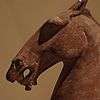Trung sisters' rebellion
The Trung sisters' rebellion was an armed civil uprising in the south of Han China between 40 and 43 AD. In 40 AD, the Vietnamese leader Trưng Trắc and her sister Trưng Nhị rebelled against Chinese authorities in Jiaozhi (in what is now northern Vietnam). In 42 AD, Han China dispatched General Ma Yuan to lead an army to strike down the Yue rebellion of the Trung sisters. In 43 AD, the Han army fully suppressed the uprising and regained complete control. The Trung sisters were captured and beheaded by the Han forces.
| Trung sisters' rebellion | |||||||
|---|---|---|---|---|---|---|---|
| Part of the southward expansion of the Han dynasty | |||||||
Statue of Ma Yuan at Fuboshan, Guilin | |||||||
| |||||||
| Belligerents | |||||||
| Han China | Yue | ||||||
| Commanders and leaders | |||||||
| Ma Yuan |
Trưng Trắc Trung Nhi | ||||||
| Strength | |||||||
| 10,000 troops | unknown | ||||||
Background
In March[1] of 40 AD, the Trung sisters, Trưng Trắc (Zheng Ce) and Trưng Nhị (徵貳 Zheng Er), led the Yue people to rise up in rebellion against the Han.[1][2] It began at the Red River Delta, but soon spread to other Yue tribes along the coast to the north and south.[1] The uprising gained the support of about sixty-five towns and settlements.[2] Trung Trac was proclaimed as the queen.[1] Even though she gained control over the countryside, she was not able to capture the fortified towns.[1]
Course
The Han government (situated in Luoyang) responded rather slowly to the emerging situation.[1] In May or June of 42 AD, Emperor Guangwu gave the orders to initiate a military campaign.[1] General Ma Yuan was placed in command of the campaign to suppress the rebellion.[1] He was given the title Fubo Jiangjun (伏波將軍; General who Calms the Waves).[1]
Ma Yuan and his staff began mobilizing a Han army in southern China.[1] It comprised about 10,000 troops.[2] From Guangdong, Ma Yuan dispatched a fleet of supply ships along the coast.[1]
He led the Han army through difficult terrain towards the Red River Delta, where they arrived in early 43 AD.[1] The rebellion was stricken down in April or May.[1] The Trung sisters were captured and decapitated.[1][2] By the end of 43 AD, the Han army had taken full control over the region by defeating the last pockets of resistance.[1]
Aftermath
General Ma Yuan aggressively sinicized the culture and customs of the local people, removing their tribal ways, so they could be more easily governed by Han China.[1] He melted down the Yue bronze drums, their chieftains' symbol of authority, to cast a statue of a horse, which he presented to Emperor Guangwu when he returned to Luoyang in the autumn of 44 AD.[1]
Perception
One reason for the defeat is the desertion by rebels because they did not believe they could win under a woman's leadership.[3] The fact that women were in charge was blamed as a reason for the defeat by historical Vietnamese texts.[4] Vietnamese historians were ridiculing and mocking men for the fact that they did nothing while "mere girls", whom they viewed with revulsion, took up the banner of revolt-the Vietnamese poem which talked about the revolt of the Trung Sisters while the men did nothing was not intended to praise women nor view war as women's work as it has been wrongly interpreted.[5][6]
When the enemy is at the gate, the woman goes out fighting. has been recited as evidence of women's stature.[7] The quote is "giac den nha, dan ba cung danh" in Vietnamese and the quote actually means that fighting in war is inappropriate for women and its only when the situation is so desperate that the war has spread to their home then women should enter the war.[8][9]
See also
References
- Bielestein, Hans (1987). "Wang Mang, the restoration of the Han dynasty, and Later Han". The Cambridge History of China, Volume 1: The Ch'in and Han Empires, 221 B.C.–A.D. 220. Cambridge: Cambridge University Press. p. 271. ISBN 9780521243278.
- Yü, Ying-shih (1987). "Han Foreign Relations". The Cambridge History of China, Volume 1: The Ch'in and Han Empires, 221 B.C.–A.D. 220. Cambridge: Cambridge University Press. p. 454. ISBN 9780521243278.
- Keith Weller Taylor (April 1991). The Birth of Vietnam. University of California Press. pp. 41–. ISBN 978-0-520-07417-0.
- John P. McKay; Bennett D. Hill; John Buckler; Clare Haru Crowston; Merry E. Wiesner-Hanks; Patricia Buckley Ebrey; Roger B. Beck (16 November 2012). Understanding World Societies, Combined Volume: A Brief History. Bedford/St. Martin's. p. 134. ISBN 978-1-4576-2268-7.
- http://worldhistoryconnected.press.illinois.edu/4.3/gilbert.html
-
- Ngô Sï Liên, Dai Viet sir ky toàn thw, 3, lb. Cited in The Birth of Vietnam by Keith Weiler Taylor (Berkeley: University of California Press, 1983), p. 334.
- Nguyˆen, Van Ky. "Rethinking the Status of Vietnamese Women in Folklore and Oral History" (PDF). University of Michigan Press. pp. 87–107 (21 pages as PDF file).
- Hue-Tam Ho Tai (2001). The Country of Memory: Remaking the Past in Late Socialist Vietnam. University of California Press. pp. 1–. ISBN 978-0-520-22267-0.
- http://publishing.cdlib.org/ucpressebooks/view?docId=kt5z09q3kz&chunk.id=ss2.28&toc.id=ch06&brand=ucpress
